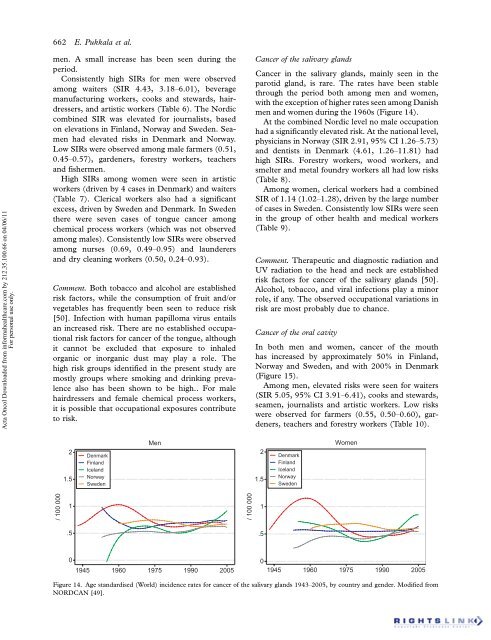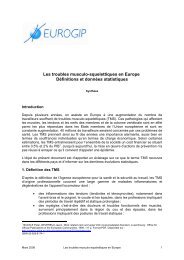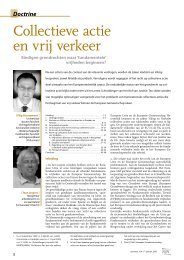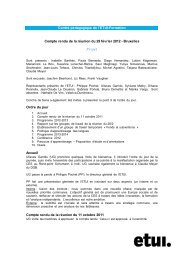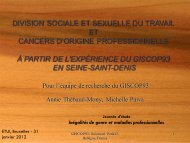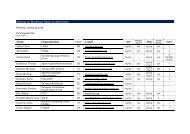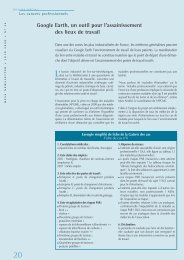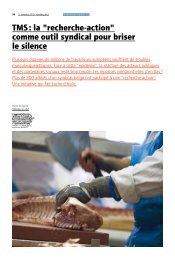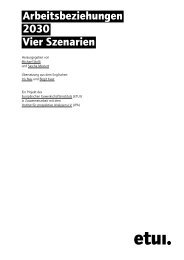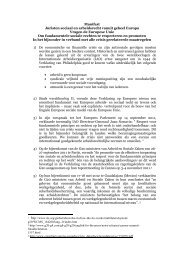Occupation and cancer - European Trade Union Institute (ETUI)
Occupation and cancer - European Trade Union Institute (ETUI)
Occupation and cancer - European Trade Union Institute (ETUI)
Create successful ePaper yourself
Turn your PDF publications into a flip-book with our unique Google optimized e-Paper software.
Acta Oncol Downloaded from informahealthcare.com by 212.35.100.66 on 04/06/11<br />
For personal use only.<br />
662 E. Pukkala et al.<br />
men. A small increase has been seen during the<br />
period.<br />
Consistently high SIRs for men were observed<br />
among waiters (SIR 4.43, 3.18 6.01), beverage<br />
manufacturing workers, cooks <strong>and</strong> stewards, hairdressers,<br />
<strong>and</strong> artistic workers (Table 6). The Nordic<br />
combined SIR was elevated for journalists, based<br />
on elevations in Finl<strong>and</strong>, Norway <strong>and</strong> Sweden. Seamen<br />
had elevated risks in Denmark <strong>and</strong> Norway.<br />
Low SIRs were observed among male farmers (0.51,<br />
0.45 0.57), gardeners, forestry workers, teachers<br />
<strong>and</strong> fishermen.<br />
High SIRs among women were seen in artistic<br />
workers (driven by 4 cases in Denmark) <strong>and</strong> waiters<br />
(Table 7). Clerical workers also had a significant<br />
excess, driven by Sweden <strong>and</strong> Denmark. In Sweden<br />
there were seven cases of tongue <strong>cancer</strong> among<br />
chemical process workers (which was not observed<br />
among males). Consistently low SIRs were observed<br />
among nurses (0.69, 0.49 0.95) <strong>and</strong> launderers<br />
<strong>and</strong> dry cleaning workers (0.50, 0.24 0.93).<br />
Comment. Both tobacco <strong>and</strong> alcohol are established<br />
risk factors, while the consumption of fruit <strong>and</strong>/or<br />
vegetables has frequently been seen to reduce risk<br />
[50]. Infection with human papilloma virus entails<br />
an increased risk. There are no established occupational<br />
risk factors for <strong>cancer</strong> of the tongue, although<br />
it cannot be excluded that exposure to inhaled<br />
organic or inorganic dust may play a role. The<br />
high risk groups identified in the present study are<br />
mostly groups where smoking <strong>and</strong> drinking prevalence<br />
also has been shown to be high.. For male<br />
hairdressers <strong>and</strong> female chemical process workers,<br />
it is possible that occupational exposures contribute<br />
to risk.<br />
/ 100 000<br />
2<br />
1.5<br />
1<br />
.5<br />
Denmark<br />
Finl<strong>and</strong><br />
Icel<strong>and</strong><br />
Norway<br />
Sweden<br />
Men<br />
0<br />
1945 1960 1975 1990 2005<br />
/ 100 000<br />
Cancer of the salivary gl<strong>and</strong>s<br />
Cancer in the salivary gl<strong>and</strong>s, mainly seen in the<br />
parotid gl<strong>and</strong>, is rare. The rates have been stable<br />
through the period both among men <strong>and</strong> women,<br />
with the exception of higher rates seen among Danish<br />
men <strong>and</strong> women during the 1960s (Figure 14).<br />
At the combined Nordic level no male occupation<br />
had a significantly elevated risk. At the national level,<br />
physicians in Norway (SIR 2.91, 95% CI 1.26 5.73)<br />
<strong>and</strong> dentists in Denmark (4.61, 1.26 11.81) had<br />
high SIRs. Forestry workers, wood workers, <strong>and</strong><br />
smelter <strong>and</strong> metal foundry workers all had low risks<br />
(Table 8).<br />
Among women, clerical workers had a combined<br />
SIR of 1.14 (1.02 1.28), driven by the large number<br />
of cases in Sweden. Consistently low SIRs were seen<br />
in the group of other health <strong>and</strong> medical workers<br />
(Table 9).<br />
Comment. Therapeutic <strong>and</strong> diagnostic radiation <strong>and</strong><br />
UV radiation to the head <strong>and</strong> neck are established<br />
risk factors for <strong>cancer</strong> of the salivary gl<strong>and</strong>s [50].<br />
Alcohol, tobacco, <strong>and</strong> viral infections play a minor<br />
role, if any. The observed occupational variations in<br />
risk are most probably due to chance.<br />
Cancer of the oral cavity<br />
In both men <strong>and</strong> women, <strong>cancer</strong> of the mouth<br />
has increased by approximately 50% in Finl<strong>and</strong>,<br />
Norway <strong>and</strong> Sweden, <strong>and</strong> with 200% in Denmark<br />
(Figure 15).<br />
Among men, elevated risks were seen for waiters<br />
(SIR 5.05, 95% CI 3.91 6.41), cooks <strong>and</strong> stewards,<br />
seamen, journalists <strong>and</strong> artistic workers. Low risks<br />
were observed for farmers (0.55, 0.50 0.60), gardeners,<br />
teachers <strong>and</strong> forestry workers (Table 10).<br />
2<br />
1.5<br />
1<br />
.5<br />
Denmark<br />
Finl<strong>and</strong><br />
Icel<strong>and</strong><br />
Norway<br />
Sweden<br />
Women<br />
0<br />
1945 1960 1975 1990 2005<br />
Figure 14. Age st<strong>and</strong>ardised (World) incidence rates for <strong>cancer</strong> of the salivary gl<strong>and</strong>s 1943 2005, by country <strong>and</strong> gender. Modified from<br />
NORDCAN [49].


